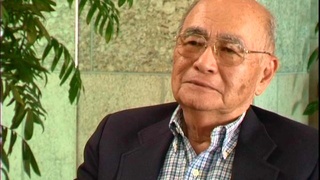Interviews
Contemplating identity in Los Angeles
The question of, like, an identity or especially racial identity is something that always you’ll find with young people in LA, especially. It comes up all the time because LA is so diverse. I went to school in the Valley where a lot of kids got bussed in from the city and it was very…it’s a really mixed place to be. I think that…all my friends growing up – especially when I was at school in like the Woodland Hills area – they had…all my friends were different backgrounds, different races, different religion and what not.
And I think that really does become a question when you’re a younger person. “So where do I fit in? Where do I belong?” Because there’s a certain point where nobody really cares. Everybody’s just friends because that’s who you fall into place with and who you get along with. But then there’s s certain point of starting to really identify with other people and obviously, as a mixed…a person of mixed background…my dad being Japanese and my mom is like a mixed Caucasian – pretty much American, like her side of the family, a lot of the different parts of the family tree date back to the earliest colonies in the States and whatever. I mean that’s…it’s funny because that side of it is just so Caucasian, so White, so whatever. And then the other side, it’s like there’s a difference between being Japanese and being Japanese American and you start to really realize that as you get older.
Date: January 16, 2006
Location: California, US
Interviewer: Chris Komai and John Esaki
Contributed by: Watase Media Arts Center, Japanese American National Museum
Explore More Videos

Wife's family in Japan
(b.1942) Japanese American ceramist, who has lived in Japan for over 30 years.

Lack of notion of citizenship in Japan
(b.1935) American born Japanese. Retired businessman.

Lack of language skills
(b.1964) California-born business woman in Japan. A successor of her late grandmother, who started a beauty business in Japan.

Preserving traditional Japanese culture
(b.1964) California-born business woman in Japan. A successor of her late grandmother, who started a beauty business in Japan.

Having patience in Japan, being both
(b.1964) California-born business woman in Japan. A successor of her late grandmother, who started a beauty business in Japan.


Being on the outside
(b.1948) Nikkei from Southern California living in Japan.

His parents' experience with Japanese resistance toward intermarriage with Okinawans
(b.1925) Nisei of Okinawan descent. Had a 38-year career in Japan as a baseball player, coach, scout, and manager.

Working in cane fields as teenager, and how it helped in his athletic training (Japanese)
(b.1925) Nisei of Okinawan descent. Had a 38-year career in Japan as a baseball player, coach, scout, and manager.

Nickname
(b.1913) Kibei from California who served in the MIS with Merrill’s Marauders during WWII.

Mixed emotions after declaration of war on Japan
(b.1913) Kibei from California who served in the MIS with Merrill’s Marauders during WWII.

Growing up in Waikiki
(b. 1924) Political scientist, educator, and administrator from Hawai`i

The philosophy of playing Taiko
(b.1951) Co-founder and managing director of San Jose Taiko.

Learning Japanese traditions by observing his mother and grandmother
(b. 1981) Enka Singer

Nihongo gakko - Preserving Japanese culture (Spanish)
(b. 1969) Former president of Centro Nikkei Argentino.
